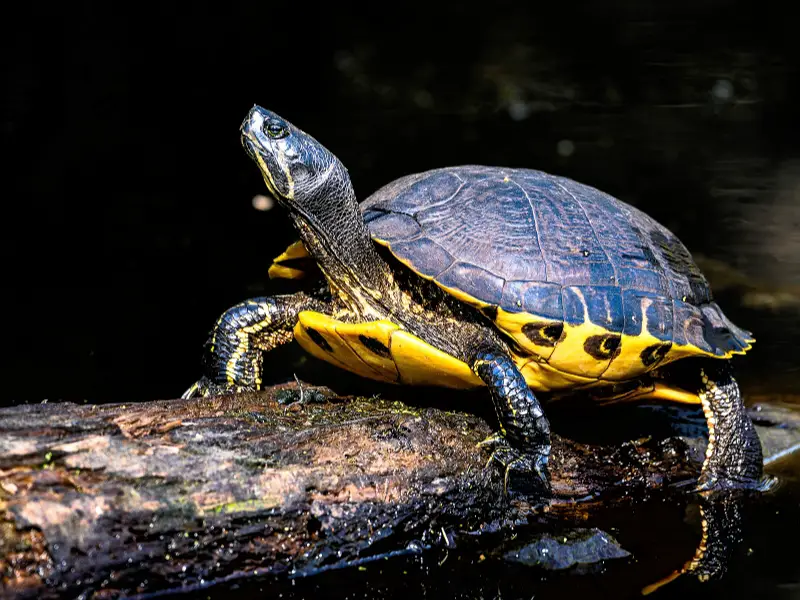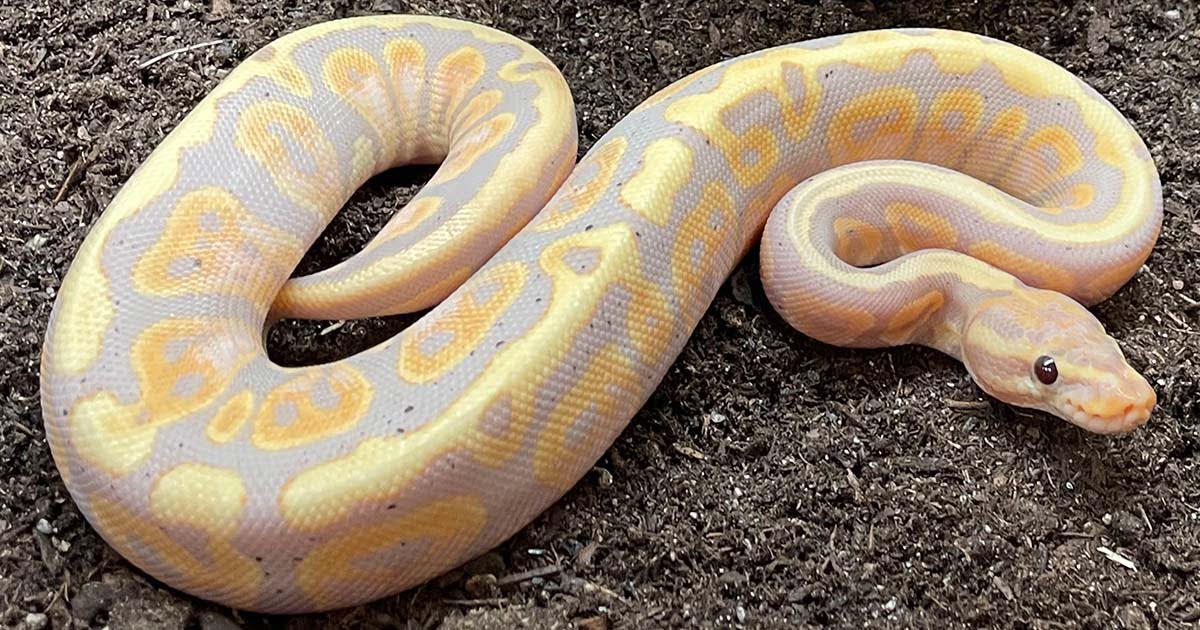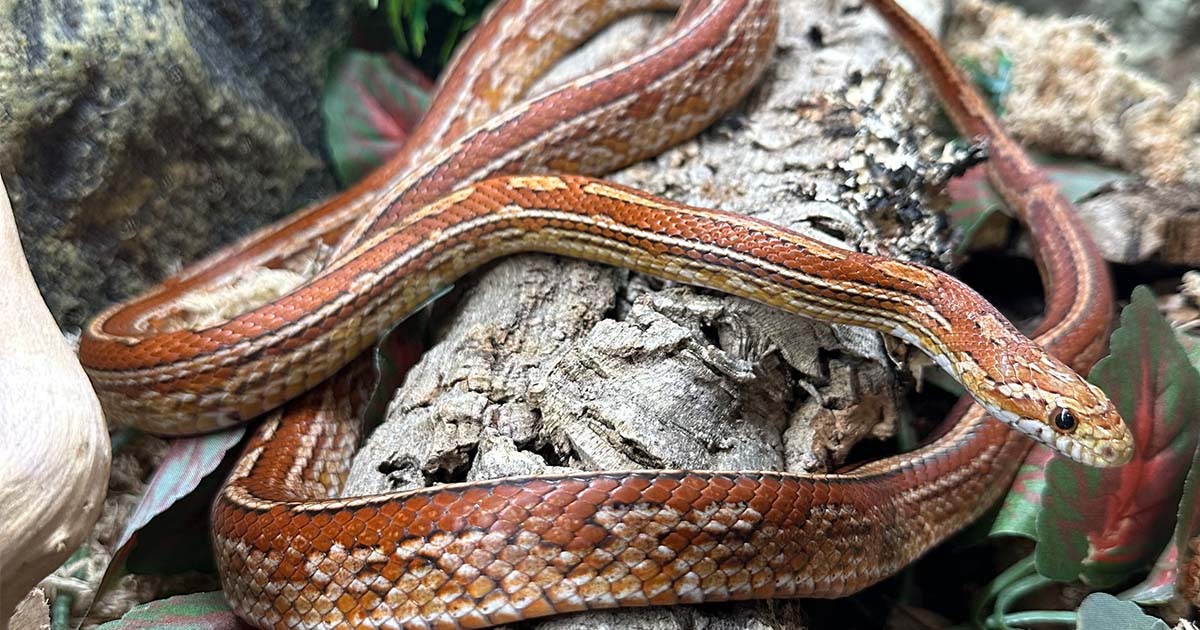The Cumberland slider, also known as the Cumberland river turtle or Cumberland terrapin, is a semi-aquatic freshwater turtle native to the Cumberland River in the Southeastern United States. These turtles are known for their distinct red markings on their neck and head, which make them a popular choice for pet owners and collectors.
As fascinating as these turtles are, they require a lot of care and attention to ensure that they live long, healthy lives.
In this guide, we will delve into the world of the Cumberland slider and discuss the best practices for providing optimal care for these captivating creatures. If this turtle species has gained your interest, keep reading to know what to expect.
Quick Facts
| Common name | Cumberland river turtle, Cumberland terrapin, Cumberland turtle |
| Scientific name | Trachemys scripta troostii |
| Adult size | 5-8″ |
| Lifespan | 20-40 years |
| Diet | Plants, insects, fish, small animals |
| Tank size | 20 gallons for juveniles, 75 gallons for an adult pair |
| Humidity & temperature | UVB lighting; water temperature 70-75 degrees, basking area 90 degrees |
| Popular alternatives | Red-eared sliders, painted turtles, map turtles |
What is a Cumberland Slider?
The Cumberland slider – sometimes called the Cumberland turtle – is a semi-aquatic reptile commonly found throughout the Mississippi and Tennessee River drainages in the Southeastern United States. These turtles have earned the nickname “slider” because they tend to slide into the water when they sense danger while basking in the sun.
In addition to providing protection from predators, the deep waters offer a suitable environment for the Cumberland slider to hunt for prey and explore its surroundings.
Considering this natural behavior is essential when creating a suitable habitat for your pet slider. Provide a basking area with easy access to both land and water to allow your pet to perform this behavior, which is crucial for their physical and mental well-being.
Cumberland sliders are popular pets and a particular favorite among turtle enthusiasts for several reasons.
Firstly, they have a distinctive and attractive appearance, with a dark green or brown top shell and yellow stripes along the sides of their head and neck. Their striking appearance makes them a visually appealing addition to any aquarium.
Another reason for their popularity is their behavior. Cumberland sliders are active and engaging, often exhibiting playful behavior. They enjoy basking in the sun, swimming, and exploring their surroundings, making them fascinating creatures to interact with.
Cumberland sliders are also relatively easy to care for, making them an excellent choice for first-time turtle owners. They have an omnivorous diet, feeding on a variety of plants, insects, fish, and small animals. Their dietary requirements are fairly easy to meet and can be supplemented with commercial turtle food.
Furthermore, Cumberland sliders are social animals and can be kept in groups, making them a great addition to a community tank. They are also relatively docile and can be handled with care, making them an ideal choice for children and families.
In addition to their attractive appearance and engaging behavior, Cumberland sliders have a long lifespan with proper care and attention. This allows pet owners to form a long-lasting bond with their turtles, making them a treasured addition to any household.
Cumberland Slider Care Sheet
Cumberland sliders are fascinating creatures commonly kept as pets for various reasons we’ve discussed already. However, proper care and attention are absolutely vital to ensure that these turtles remain healthy and happy in captivity.
To help new and experienced turtle owners alike, we’ll dive into a comprehensive care sheet that covers all aspects of their care, including habitat setup, feeding, and health considerations.
By following these guidelines, you can ensure that your pet Cumberland slider thrives in its captive environment and remains a beloved part of your family for many years to come.
Tank and Enclosure
Providing the right living conditions for turtles is crucial to their overall health and well-being as family pets. When it comes to Cumberland sliders, proper housing and water temperature are particularly important considerations.
For juvenile turtles, a 10- to 20-gallon tank is sufficient, while adult sliders require a larger 55-gallon tank, and a 75-gallon tank can house a pair of adults. Alternatively, they can be housed outdoors, but extra care must be taken to protect them from the elements.
Fresh, filtered water is a must for your turtle’s tank, and a high-quality filtration system should always be in place. UVB lighting is also necessary to keep your turtle healthy, and you can turn the lights off at night to mimic natural cycles.
The ideal substrate for Cumberland sliders is finely crushed pea gravel or reptile sand, but if using gravel, make sure it is large enough that your turtle cannot eat it. You can often find the right type of substrate for this breed in well-stocked pet stores.
Your turtle needs plenty of room for swimming, and there should be an area for basking where your pet can completely climb out of the water. This area should be large enough to allow your turtle to dry off completely, stretch out, and relax.
The water should be warmed to 70-75°F, and the basking area should be heated to 90°F. Maintain a cooler zone at the opposite end of the tank from the basking area, with temperatures dropping to 65°F at night. Daytime temperatures in the tank should range from the upper 70s to the lower 80s.
If you have multiple Cumberland sliders, you may see them basking together, which is a behavior characteristic of this species. By providing the right living conditions and habitat, you can ensure that your pet Cumberland Slider thrives and remains healthy for years to come.
Who doesn’t love a happy turtle, truly satisfied with its living conditions?
What Does a Cumberland Slider Eat?
Cumberland sliders are omnivorous. Unlike your average 11-year-old human child, these creatures are not picky eaters. They have a diverse diet that includes a variety of plant and animal matter.
Some of their favorite foods include commercial turtle food pellets, live or frozen fish, shrimp, earthworms, mealworms, crickets, and fruits and vegetables such as carrots, squash, and lettuce.
Providing a balanced and varied diet for your Cumberland Slider is essential to ensure they get all the necessary nutrients for a healthy and long life. Feeding them a diet consisting solely of pellets is not recommended, as it can lead to nutritional deficiencies and health problems.
When feeding your turtle, make sure to remove any uneaten food from the tank to prevent bacterial growth and water pollution. It’s also important to offer your turtle a calcium supplement, such as cuttlebone or calcium powder, to support healthy shell and bone growth.
Feeding Schedule
Feeding your Cumberland sliders on a regular schedule is crucial for their health and happiness. But it’s not just about what they eat; it’s also important to know when and how much to feed them.
Younger turtles under six months of age should be fed once a day with a combination of commercial pellets and protein-rich foods like worms, crickets, and small fish. Make sure not to overfeed them, as their appetites can be deceiving.
Once they reach six months, you can add green leafy vegetables like lettuce to their diet, but reduce the frequency of their feedings to every alternate day. Overfeeding, especially with high protein foods, can cause health issues like shell deformities, concentric rings on the shell, and damage to the liver and kidneys.
If you notice any signs of overfeeding, like a bumpy shell, it’s time to cut back on protein.
As your turtles grow to adulthood, you can adjust their feeding schedule to two to three times a week or as much as needed to satisfy their appetite. Remember, a balanced diet and a proper feeding schedule will ensure that your Cumberland slider turtles live long and healthy lives.
Predators
- s. troostiifaces a wide range of predators in the wild, including but not limited to alligators, wading birds, predatory fishes, raccoons, otters, foxes, skunks, coyotes, and armadillos. Even certain mammals like marsupials and American minks are known to prey on them.
These turtles are not safe from harm even when they lay eggs, as largemouth bass, white-tailed deer, and striped skunks are also known to feed on their eggs.
Unfortunately, humans are also a threat to these turtles. Some people intentionally shoot them, while others accidentally harm them with vehicles. It’s important to remember that these turtles play a vital role in their ecosystem, and their protection is crucial for maintaining a balanced environment.
How to Keep Them Healthy
Turtles are amazing creatures with long lifespans, and Cumberland slider turtles are no exception. Although they may not live as long as their tortoise cousins, they can still be your companion for up to 30 years! With proper care, your turtle can become a treasured friend, accompanying you through many milestones, from your high school graduation to your firstborn!
However, caring for a turtle requires attention to detail and a commitment to meeting its needs. A healthy diet is essential; as discussed, Cumberland sliders prefer a mixed diet consisting of commercial pelleted turtle food supplemented with mealworms, crickets, and leafy green vegetables, amongst other foods.
Proper hygiene is also crucial, as maintaining a clean living environment and providing fresh water with a filtration system can prevent illness and promote health.
In addition, providing general attention to your turtle is important for its well-being. Refrain from placing heavy decorations in their aquarium that could injure them, and keep them away from inexperienced hands.
All in all, a Cumberland slider turtle can be a wonderful pet that brings joy and companionship for many years. Just be sure to provide the proper care they need to thrive!
Cumberland Slider Behavior
In a similar vein to sugar gliders, guinea pigs, and hedgehogs, Cumberland slider turtles are popular pets thanks to their active and entertaining behavior. These little critters love to swim and bask in the sun, making them quite a sight to behold. As established, their name comes from their tendency to slide into the water when they are frightened while basking.
If you own more than one of these little critters, you may witness them basking together in a group, stacking themselves on top of one another. This is not only a cute sight, but it’s also a sign that your turtles are comfortable with their environment and feel safe around each other.
Keeping multiple turtles can make for a more lively and engaging pet ownership experience if you’re interested and have the space for a larger tank.
Handling
Handling a Cumberland slider turtle is often a fun and rewarding experience, but it’s essential to do it correctly to ensure the safety of the turtle and yourself.
The first thing to keep in mind is that turtles are not the same as dogs or cats – they don’t naturally enjoy being handled. However, with time and patience, they can become accustomed to it.
Before handling your Cumberland slider, make sure your hands are clean and free of any harmful chemicals or bacteria. Avoid using soap, as it can be harmful to the turtle. You can use water to rinse your hands and remove any dirt or debris.
To pick up your turtle, approach it slowly and calmly. Gently scoop it up from underneath with both hands, making sure not to squeeze too tightly or lift it too high off the ground. It’s important to support the turtle’s entire body, including its legs and tail, to prevent any injuries.
Once you have picked up your Cumberland slider, avoid holding it for too long. It’s best to keep handling sessions short and infrequent, especially if your turtle is still getting used to being handled. As a general rule, you should only handle your turtle for a maximum of 15 minutes at a time.
Return your turtle to its habitat gently and slowly when you’re finished handling it. Make sure to rewash your hands with water, but avoid using soap or any other chemicals that could harm your turtle.
Remember, while handling your Cumberland slider can be an enjoyable experience, it’s important to respect your pet’s boundaries and always handle it with care and caution.
Appearance
The Cumberland slider is a unique-looking aquatic turtle that is instantly recognizable due to its striking appearance. Their shells are typically dark brown or black in color, with a yellow or orange stripe running down the center of the shell, starting from the head and ending at the tail. The stripe is often surrounded by a lighter color that can range from a creamy yellow to a golden brown, which creates a beautiful contrast against the darker hue of the shell.
One of the most striking features of the Cumberland slider is its eyes. These turtles have large, bright eyes positioned towards the top of their head, allowing them to easily spot predators or prey while swimming. Their eyes are surrounded by a distinctive yellow ring, which adds a pop of color to their appearance.
This turtle’s body is streamlined and perfectly designed for swimming. They have four strong, webbed feet that they use to paddle through the water with ease. Their feet are typically a darker color than their shell, which helps them blend in with their surroundings while swimming.
This turtle’s head and neck are elongated and flexible, which allows the reptile to reach out and snatch prey with ease. The top of their head is typically a darker color, while the underside is lighter in color.
One interesting feature of the Cumberland slider – and of all turtles, for that matter – is their ability to retract their head into their shell for protection. When threatened, they can quickly retract their head and limbs, closing the shell tightly around their body to protect themselves from predators.
How Much Does a Cumberland Slider Typically Cost?
The price of a Cumberland slider turtle can vary depending on several factors, such as age, size, and availability. On average, a juvenile Cumberland Slider can cost anywhere between $10 to $30, while an adult turtle can cost upwards of $50 to $100 or more.
The availability of these turtles may also affect their price. If they are in high demand or difficult to find in your area, the price may be higher.
It’s important to keep in mind that the cost of the turtle is just one aspect of the expense of owning one as a pet. You also need to factor in the price of their habitat, food, and any necessary equipment for their care. It’s essential to ensure that you can afford the long-term cost of owning a Cumberland Slider before bringing one home as a pet.
Moreover, it’s crucial to purchase turtles from reputable breeders or pet stores to ensure that they are healthy and well-cared for. You should avoid buying turtles from pet stores with questionable conditions or from online marketplaces without proper verification.
A healthy and ethically-raised turtle may be more expensive initially, but it can save you money and heartache in the long run.
Care Guide Summary
Caring for a Cumberland slider will always be an exciting experience, but it also comes with significant responsibilities. By providing a suitable environment for them to thrive in, you can help ensure the survival and well-being of your new reptilian friend.
Many people are charmed by the idea of owning a unique and delightful pet like a Cumberland slider but aren’t sure where to start. We hope this guide pushes you one step closer to adding a semi-aquatic companion to your home and experiencing their fun, joyful playtime sessions in your everyday life!



